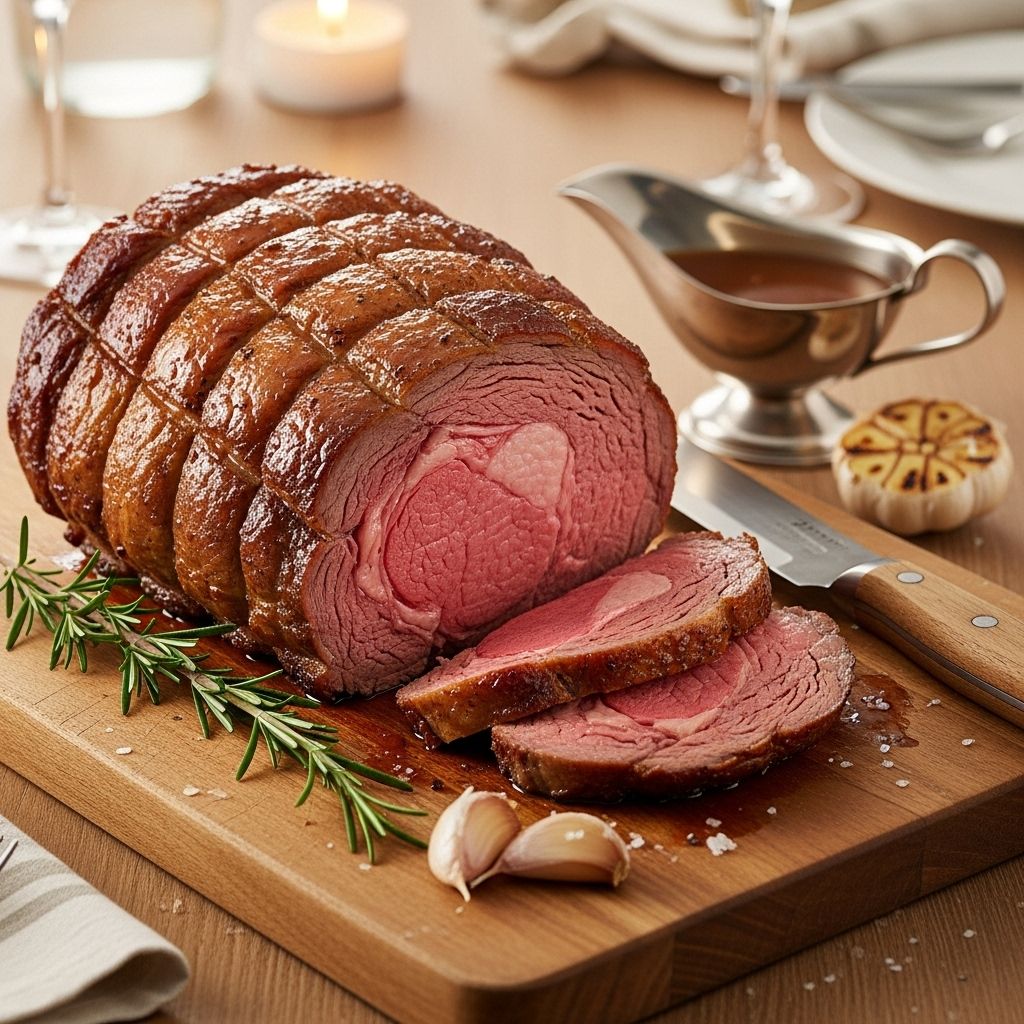How to Make Perfect Prime Rib for Christmas Dinner: A Comprehensive Guide
Simple science-backed methods ensure a tender, flavorful roast worthy of any holiday feast.

How to Make Perfect Prime Rib for Christmas Dinner
Prime rib stands as the ultimate centerpiece for Christmas or any special celebration—a showstopper with its bold flavor, tender texture, and striking presentation. This guide unpacks every essential detail, from selecting the right beef to carving beautifully, so you can serve an unforgettable meal. Drawing from culinary expertise, science-backed techniques, and years of holiday tradition, here’s everything you need to make prime rib perfection happen at home.
Why Prime Rib Is the Holiday Centerpiece
Few dishes evoke as much festivity and delight as a prime rib roast. Its large format feeds a crowd, its rich marbling ensures deep flavor, and its impressive appearance commands attention at the dinner table. Traditional accompaniments and classic sides make it a beloved holiday staple.
- Bold, beefy flavor from marbling and bone-in cooking.
- Roasted crust for satisfying texture and taste.
- Presentation: A whole roast makes any gathering feel special.
Choosing Your Prime Rib: Grades, Cuts, and Sizing
Success starts at the butcher counter. Understanding grades, cuts, and sizing ensures your dish shines on the big day.
Prime versus Choice: Why Grade Matters
| Grade | Description | Recommended For |
|---|---|---|
| Prime | Highest marbling, super tender and juicy | Best for special occasions |
| Choice | Less marbling, still flavorful | Good alternative if Prime unavailable |
| Select | Lowest fat, least flavor | Not generally recommended |
If budget allows, opt for USDA Prime, but USDA Choice is also excellent. Look for visible fat marbling for best results.
Bone-In vs. Boneless Prime Rib
- Bone-in: Adds flavor, slows cooking, produces a more impressive roast.
- Boneless: Easier to carve, cooks more quickly.
Many chefs recommend bone-in for richer flavor and better insulation, but boneless is practical and still delicious.
How Much Prime Rib Per Person?
- For bone-in roast: plan about one pound per guest.
- For boneless roast: plan about three-quarters pound per guest.
This accounts for bone and fat loss during roasting and ensures generous portions.
Prepping Your Roast: Seasonings, Temperatures, and Resting
The best prime rib starts with smart seasoning and proper temperature management.
Seasoning: Keep It Simple
- Salt: Use kosher salt liberally for flavor and moisture retention.
- Black Pepper: Freshly ground for warmth and aroma.
- Optional Herbs & Spices: Garlic powder, thyme, paprika, and rosemary for depth.
Season your roast at least 24 hours in advance whenever possible. This allows salt to penetrate for enhanced flavor and tenderness.
Room Temperature Matters
Let your roast stand at room temperature for 1–2 hours before cooking. This helps ensure even roasting and accurate doneness.
The Science of Prime Rib: Cooking Techniques Explained
Prime rib’s perfection comes from understanding meat science and applying the right roasting method. Two main techniques are recommended for best results:
Low-and-Slow Roasting
- Roast at 225–250°F (107–121°C) for a slow, gentle cook.
- Creates evenly rosy interior and tender texture.
- Helps avoid gray banding (overcooked outer layer).
Reverse Sear Method
- First: Roast low and slow until nearly done.
- Finish: Blast at high heat (500–550°F/260–288°C) for crisp crust.
- Benefit: Maximum juiciness, stunning crust, and even color.
This technique is chef-endorsed for restaurant-quality results at home.
Prime Rib Cooking Times and Doneness Chart
Precise timing depends on oven settings, roast size, and personal taste. Here’s a helpful doneness reference:
| Doneness | Internal Temp | Description |
|---|---|---|
| Rare | 120–125°F (49–52°C) | Very pink, soft |
| Medium Rare | 130–135°F (54–57°C) | Bright red center, most popular |
| Medium | 135–140°F (57–60°C) | Pink throughout |
| Medium Well | 145–150°F (63–66°C) | Some pink |
| Well Done | 155°F+ (68°C+) | Little or no pink |
Tip: Always use an instant-read thermometer for accuracy! Remove from heat when roast is 5–10°F below target (carryover heat will finish the job during resting).
Step-by-Step: How to Cook Prime Rib
- Preheat oven to 225–250°F (107–121°C) for slow roasting.
- Season roast thoroughly with salt, pepper, and any chosen herbs at least 24 hours in advance.
- Let roast come to room temperature before placing in oven.
- Place roast bone-side down on a rack set inside a roasting pan.
- Roast until meat reaches desired internal temperature (see chart above).
- Rest roast for 30–45 minutes, loosely tented with foil.
- Increase oven to 550°F (288°C), return roast for 5–10 minutes to crisp the crust (reverse sear).
- Rest again for 15 minutes for juices to redistribute.
- Carve and serve!
Expert Tips for Prime Rib Success
- Thermometer: Never guess—use a quality probe for internal temperature.
- Resting is Key: A proper rest allows juices to settle for perfect slices.
- Rack Use: Keeps roast elevated for even cooking.
- Tied roast: Tying with butcher’s twine helps maintain uniform shape and even doneness.
- Fat cap: Leave some fat—trims help baste meat during cooking.
- Herb Butter: Mix butter, thyme, paprika, garlic powder, onion powder, salt, and pepper for a flavor-packed rub.
Classic Prime Rib Accompaniments
Side dishes and sauces complement prime rib, rounding out the festive meal.
- Yorkshire Pudding: Traditional pairing made from roast drippings.
- Horseradish Sauce: Adds bright, spicy contrast.
- Au Jus: A simple pan sauce made from beef drippings for moisture and flavor.
- Creamed Spinach and Mashed Potatoes: Classic comfort sides.
- Roasted Vegetables: Carrots, Brussels sprouts, parsnips for color and nutrition.
Troubleshooting: Prime Rib Problems & Solutions
Encountering an obstacle? Here are common issues and reliable fixes:
- Roast not browned? Try reverse sear—blast at high heat after resting for a crisp crust.
- Too rare or overcooked? Monitor with a thermometer; roast low and slow for even doneness.
- Dry slices? Make sure to rest adequately and cut across the grain with a sharp knife.
- Uneven cooking? Use a rack and rotate roast mid-way for even exposure.
Carving and Serving Prime Rib
Proper carving is essential for a beautiful plate and happy guests.
- Remove bones if bone-in; slice between bones and roast, then set aside.
- Slice roast into thick slabs—about 1/2 to 1 inch for entrée portions.
- Cut against the grain for maximum tenderness.
- Serve immediately with chosen sauces and sides.
Prime Rib FAQ
Q: Can I cook prime rib ahead of time?
A: Yes, you can slow roast in advance and reverse sear just before serving to restore crust and warmth.
Q: Is dry-aging necessary?
A: Dry-aging deepens beef flavor, but high-quality beef and proper roasting deliver excellent results without aging.
Q: Should I salt in advance?
A: Salting at least a day before improves tenderness and flavor, but even a few hours will help.
Q: How do I store leftovers?
A: Cool, wrap tightly, and refrigerate. Enjoy within 3–4 days; gently reheat slices covered at low temperature to prevent drying out.
Frequently Asked Questions
Q: How do I get a perfect medium-rare?
A: Roast at low temperature to 130–135°F (54–57°C) internally, then rest and finish with a high-heat sear if desired.
Q: Can I use boneless prime rib?
A: Absolutely—adjust portion sizing and roasting time as boneless cooks faster and is easier to carve.
Q: What herbs pair best with prime rib?
A: Thyme, rosemary, garlic, and paprika blend well. Mix into butter for a flavorful rub.
Q: What’s the best pan to use?
A: A sturdy roasting pan with a rack allows air circulation and caramelization.
Q: Should I cover the roast while cooking?
A: No, roast uncovered. Cover loosely while resting to retain heat without steaming the crust.
Prime Rib Recipe Cheat Sheet
- 1 bone-in (or boneless) prime rib roast (allow 1 lb/guest if bone-in)
- Kosher salt and freshly ground pepper
- Herb butter: blend softened butter, thyme, paprika, garlic powder, onion powder, salt, and pepper
- Roasting rack and pan
- Instant-read digital thermometer
Instructions: Season, rest, slow-roast, reverse sear, rest, carve, and serve.
Conclusion
Mastering prime rib involves thoughtful preparation, attention to temperature, and patient roasting. With these techniques and tips, you can present a festive feast that will be remembered for years. Whether you’re an experienced cook or trying this dish for the first time, follow each step and bring restaurant-quality flavor home for Christmas dinner.
Read full bio of Anjali Sayee












